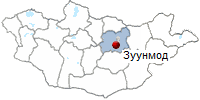The Tuv aimag is located in the center of Mongolia and includes the Capital city of Mongolia in its territory.
ABOUT MONGOLIA
THE REGIONS OF MONGOLIA
TUV (TOV) AIMAG.

- Territory - 28,571 sq, miles (74,000 sq. km.)
- Center - Zuunmod town, located 28 miles (45 km.)
from Ulaanbaator.
- Number of somons - 27
- Population - 111,900
- Tuv aimag was established in 1931

Ulaanbaatar is an autonomous municipality; the aimag which surrounds it is called Tov, which means "central'. Just an hour's drive from Ulaanbaatar
are restored monasteries in beautiful valleys, and mountains with some wonderful hiking. A large section of the aimag is part of the
Gorkhi-Terelj, Khan Khentii and Bogdkhan Uul national parks.
The ethnic groups include the Khaikh, the Kazakhs, and the Barga.
Tov may not be the wildest or most spectacular aimag in Mongolia, but it's an excellent place to start your exploration, or to see some of the countryside if
your time is limited. It has a network of good unpaved and paved roads, so you can easily use public transport to make day or overnight trips from the capital.
The annual average precipitation is 12 inches (300 mm.) in the main part of
the territory and 16 inches (400 mm.) in mountainous areas. The province is
well-known of its springs, Janchivlan, Buuruljuut, Khundgan, Estii, Yestii, Suuj.
Lakes include Dukhum, Davst, Gungaluutai, Tsaidam, Tsakhir. The soil in the
South and West of the territory is pale, brown. Various trees such as Siberian
cedar, larch, poplar, sallick, pine grow in the basin of Khentii mountains.
Common are apple manus, wild cherry, black currant, wild rose fruits, rare
liquorice, hippobopae, and medical herbs such as plaintain, bergenia, rooseroot,
thorniopsis. In the province there are 16 species of endangered animals and
birds, such as deer, does, elks, ibex, wild sheep, swans and snowcocks. The
aimag is rich in species such as squirrels, marmots, foxes, bears and lynxes.
Tourist attractions include historic places, such as Noyon Uul, Gua dov, Terelj
durvulj, Tonyukuk's grave, poems of prince Tsogt carved in rock in Duut, as old
as 450 years, impressive are the ruins of ancient cities of Hunnu, Uighur,
Turkish Khanates in the province. There are many deposits of coal, iron ore,
lead, tungsten, rocky crystal, spar, turquoise, azurite, mica, chalcedony, tin,
gold and copper. Tuv aimag produces 22 percent of grain production, and 35
percent of vegetable production of Mongolia.
PLACES TO VISIT:
ADDITIONAL INFORMATION:
PAGES OF THE PICTURE ALBUM
|